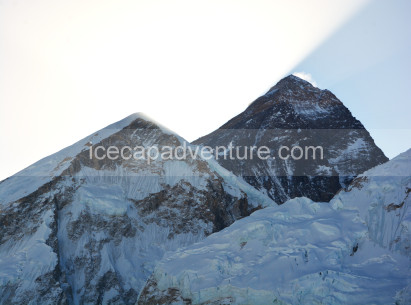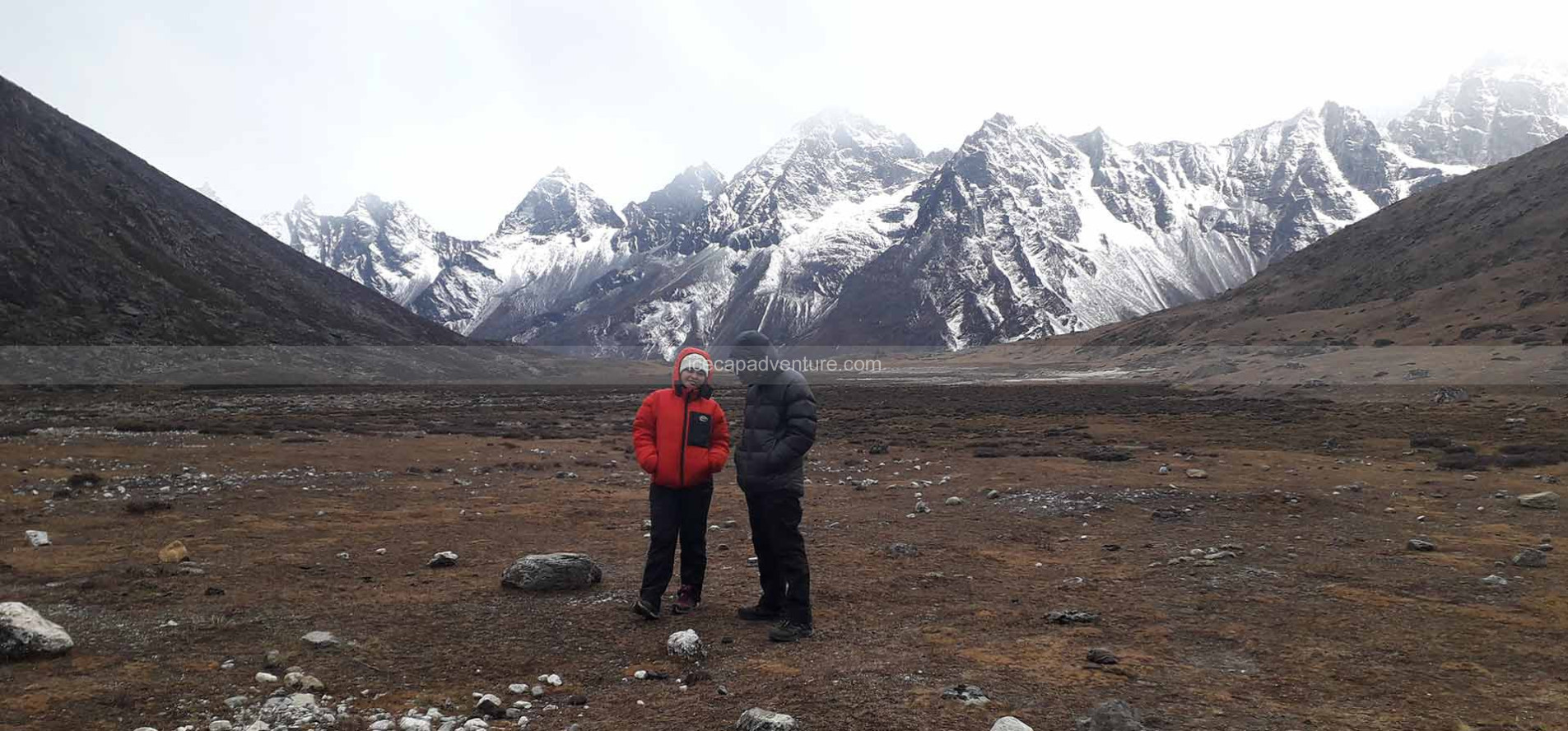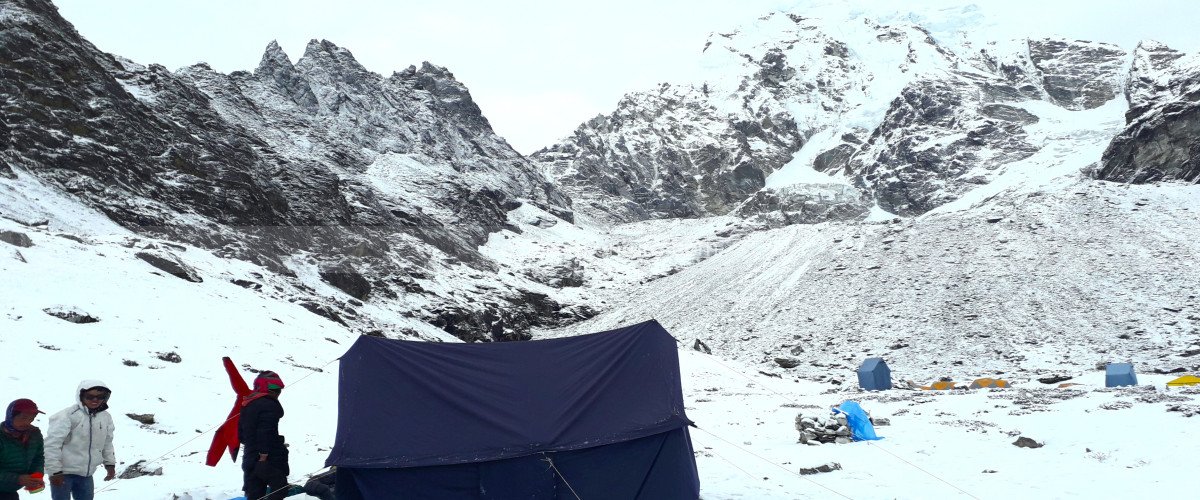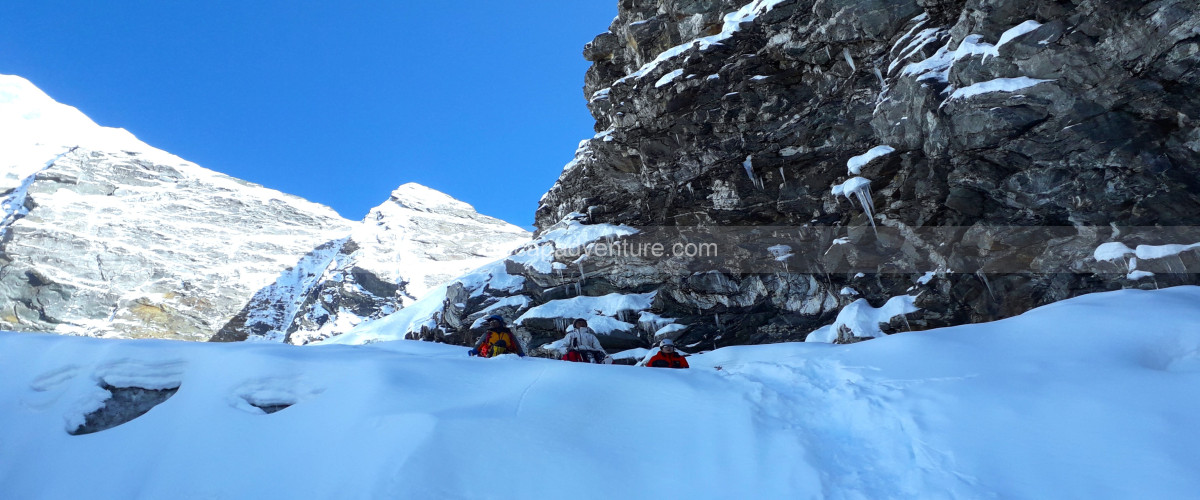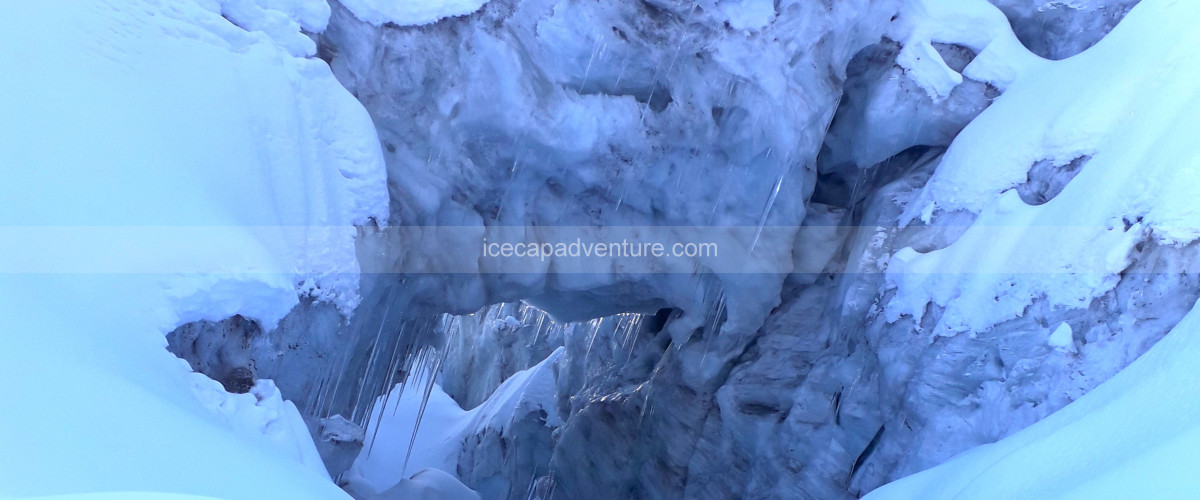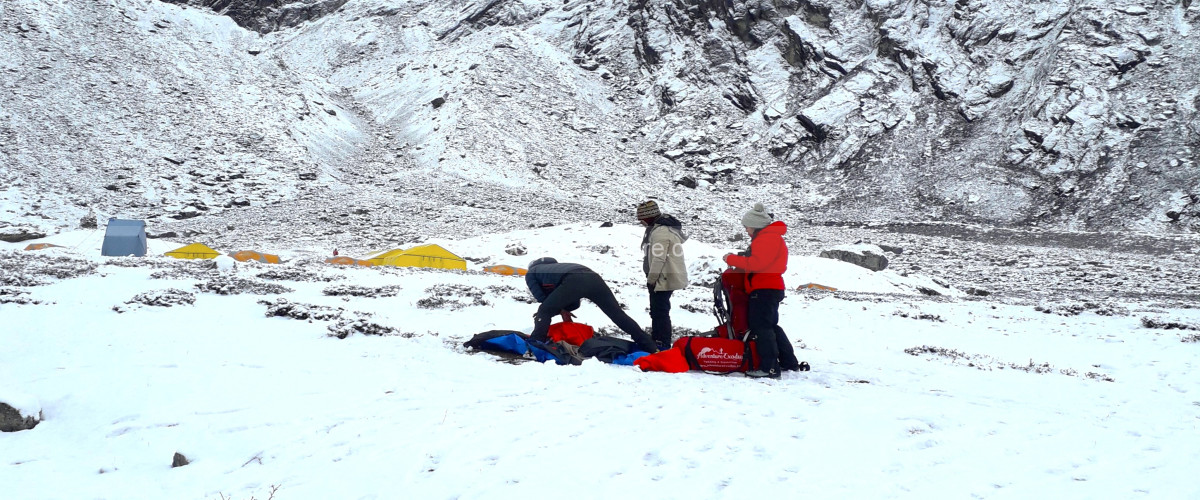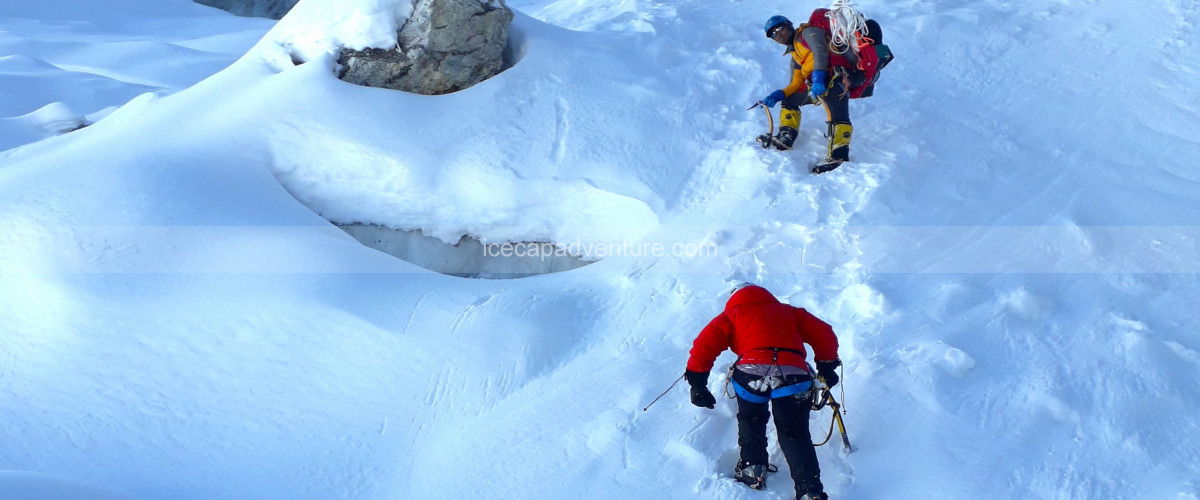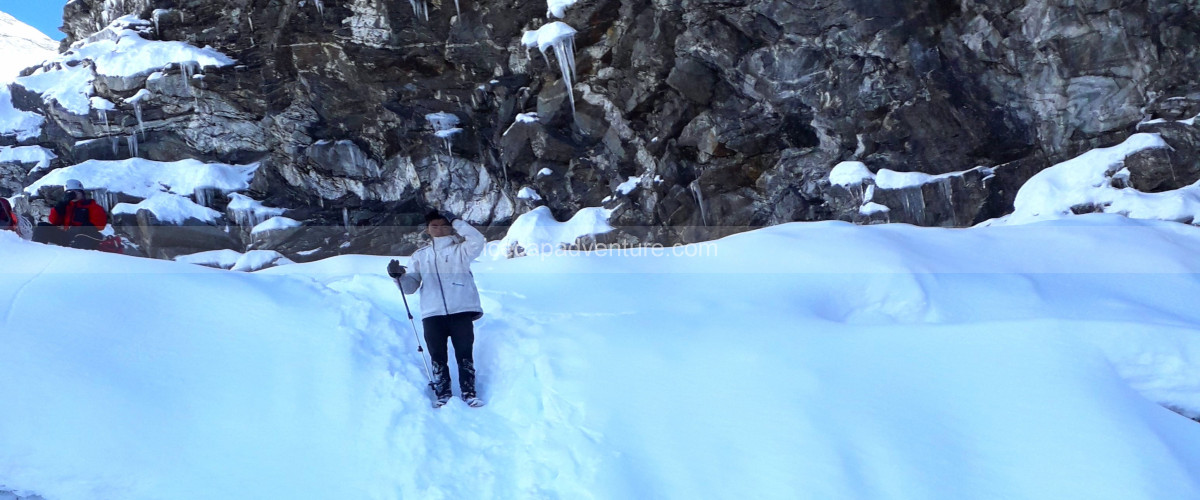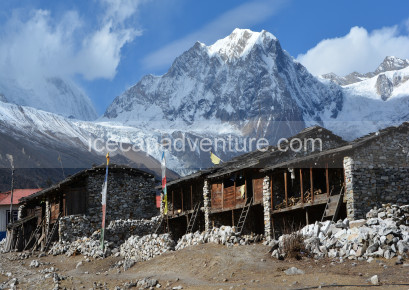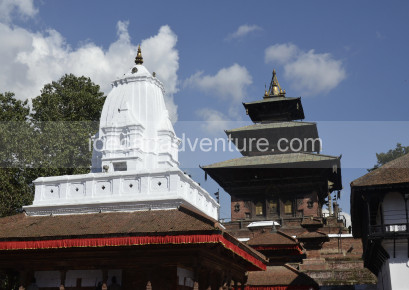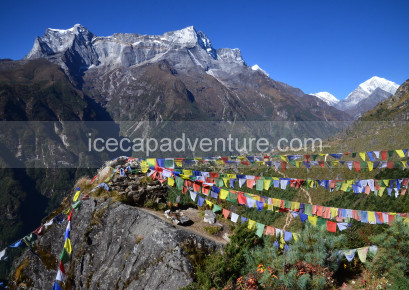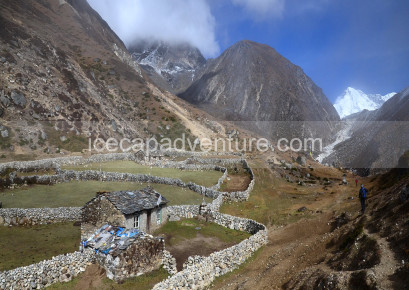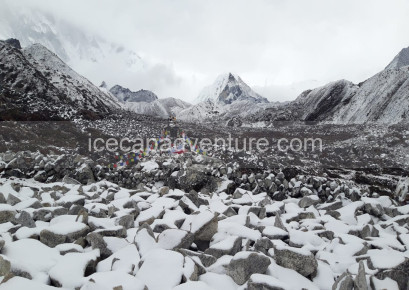.png)
.png)
.png)
.png)
.png)
.png)
.png)
.png)
Mt. Cholatse Peak Climbing – Technical Himalayan Adventure in the Everest Region
Mt. Cholatse is a striking trekking and climbing peak in the Khumbu region of Nepal, standing at 6,440 meters (21,129 ft). Famous for its technical climbing routes, Cholatse is a favorite among climbers seeking a challenging yet rewarding Himalayan summit. The mountain offers breathtaking views of Everest, Lhotse, Nuptse, Ama Dablam, and Thamserku, making it one of the most photogenic peaks in the region.
Cholatse is considered a moderately technical peak, ideal for climbers with prior high-altitude experience who want to practice ice, snow, and rock climbing techniques in preparation for higher Himalayan expeditions. Its less-crowded nature ensures a peaceful and authentic climbing experience.
Duration & Difficulty
The expedition to Cholatse typically lasts 12–15 days, including trekking to Base Camp, acclimatization, and the summit climb. It is classified as moderate to challenging, requiring climbers to have good physical fitness and familiarity with crampons, ice axes, and fixed rope climbing techniques.
Route & Climbing Strategy
The standard route ascends the North Ridge or Southwest Face, with camps as follows:
-
Base Camp (5,300m): Starting point for acclimatization and glacier approach.
-
High Camp (5,800–6,000m): Staging camp for the summit push.
-
Summit (6,440m): Steep snow and ice slopes, rock sections, and technical ridges requiring rope techniques and careful navigation.
Summit day provides panoramic views of the Everest and Ama Dablam ranges, rewarding climbers with a true high-altitude Himalayan experience.
Best Time to Climb
The most favorable climbing seasons are spring (March–May) and autumn (September–November). During these months, the weather is stable, skies are clear, and snow conditions are ideal for technical climbing. The monsoon season and winter are not recommended due to heavy snowfall and avalanche risk.
Accommodation & Meals
During the approach trek, climbers stay in tea houses or lodges with basic amenities. At Base Camp and higher camps, accommodation is in tents, with meals prepared by professional expedition cooks. High-calorie, nutritious meals are provided to maintain energy and stamina throughout the climb.
Permits & Regulations
Climbing Cholatse requires a trekking peak climbing permit from the Nepal Mountaineering Association (NMA) and a Sagarmatha National Park Permit. A TIMS Card (Trekkers’ Information Management System) is also mandatory. These permits ensure regulated climbing and help preserve the fragile Himalayan environment.
Altitude & Safety
At 6,440 meters, proper acclimatization is essential to prevent Altitude Sickness (AMS). Climbers are accompanied by experienced Sherpa guides for technical support, safety, and route navigation. Travel insurance with high-altitude helicopter evacuation coverage is strongly recommended.
Responsible Climbing
The Cholatse expedition follows eco-friendly and sustainable practices, including responsible waste management, minimizing environmental impact, and supporting local Sherpa communities through fair employment.
Flights & Transfers
The journey begins with a flight from Kathmandu to Lukla, followed by trekking through Namche Bazaar, Tengboche, Pangboche, and other Sherpa villages to Cholatse Base Camp. After the summit and descent, climbers return to Lukla for a flight back to Kathmandu.
Expedition Highlights
-
Summit Mt. Cholatse (6,440m): A technically rewarding Himalayan peak.
-
Panoramic Views: Stunning vistas of Everest, Lhotse, Ama Dablam, Nuptse, and Thamserku.
-
Technical Climbing Experience: Practice snow, ice, and rock climbing with rope techniques.
-
Khumbu Cultural Experience: Trek through Sherpa villages, monasteries, and high-altitude valleys.
-
Less Crowded Peak: Enjoy a serene climbing experience away from busy Everest routes.
-
Professional Support Team: Experienced guides, Sherpas, and cooks ensure a safe, successful expedition.
1
We will be waiting to welcome you at Tribhuvan International Airport, Kathmandu, where you will be greeted with a traditional Nepali flower garland to mark your arrival. After the warm welcome, we will drive you to your hotel, approximately 30 minutes during the day and 20 minutes at night.
Upon reaching the hotel, you will be offered welcome drinks and biscuits, followed by the settlement of your rooms. Once settled, please join us back in the lobby or meeting hall for a briefing about your peak climbing program on Cholaste Peak Climbing, including an introduction to your guide and other relevant details. After the briefing, you will have the opportunity to check your peak climbing equipment with your guide.
Note: If you arrive in Kathmandu at night, these activities will be scheduled for the following day after breakfast and meals.
.png)
.png)
.png)
.png)
2
Today marks the beginning of your Cholatse Peak Climbing adventure, one of the most striking and technically fascinating peaks in the Everest region. After breakfast, you’ll spend the day in Kathmandu (1350m) preparing for the expedition. This is an important day to ensure all your climbing gear, clothing, and personal items are well-organized and ready for the high-altitude journey ahead.
Your climbing leader and team will meet you for a comprehensive briefing covering the trekking route, safety guidelines, altitude acclimatization plan, and climbing techniques. This is also a great opportunity to ask questions, check your equipment, and make last-minute purchases or rentals from the many well-stocked outdoor gear shops in Thamel, Kathmandu’s trekking hub.
If time allows, you can explore some of the city’s UNESCO World Heritage Sites such as Swayambhunath Stupa (Monkey Temple), Boudhanath, or Pashupatinath Temple. In the evening, enjoy a welcome dinner with your guides and fellow climbers as you prepare mentally and physically for the thrilling days ahead in the Himalayas.
Highlights of the Day
-
Final preparation and equipment check for Cholatse Peak Climbing
-
Attend a detailed trekking and climbing briefing with your expedition leader
-
Explore Kathmandu’s gear shops and cultural landmarks
-
Enjoy a welcome dinner and meet your team members
.png)
.png)
.png)
.png)
3
Your exciting journey to Cholatse Peak truly begins today! After an early breakfast, you’ll transfer to Kathmandu Airport for a scenic mountain flight to Lukla (2840m) — the gateway to the Everest region. The flight itself is an unforgettable experience, offering breathtaking aerial views of snow-capped Himalayan giants, terraced hillsides, and remote valleys.
Upon landing at the famous Tenzing–Hillary Airport, you’ll meet the rest of your trekking crew and start your trek toward Phakding (2640m). The trail descends gradually through pine and rhododendron forests, passing charming Sherpa villages, fluttering prayer flags, and chortens that mark the spiritual heart of the Khumbu.
You’ll follow the Dudh Koshi River, crossing a few suspension bridges and walking along well-trodden paths surrounded by vibrant local life. The trek is relatively easy and provides the perfect warm-up for the coming days in higher altitudes. Upon reaching Phakding, settle into your teahouse and enjoy the serene mountain atmosphere.
Highlights of the Day
-
Scenic mountain flight from Kathmandu to Lukla
-
First day of trekking in the Everest region
-
Walk along the Dudh Koshi River and through Sherpa settlements
-
Enjoy Himalayan views and local culture
-
Overnight in the peaceful village of Phakding
.png)
.png)
.png)
.png)
4
After breakfast, your trek continues north along the Dudh Koshi River, crossing several suspension bridges draped with colorful prayer flags — including the iconic Hillary Suspension Bridge, one of the highest in the region. The trail winds through beautiful pine and rhododendron forests, passing the small villages of Tok Tok, Benkar, and Monjo, where you’ll enter the Sagarmatha National Park, a UNESCO World Heritage Site.
As you ascend gradually, the scenery becomes increasingly dramatic with glimpses of Thamserku (6623m) and Kusum Kanguru (6367m). After crossing a few more bridges, the trail steepens on the final climb to Namche Bazaar (3440m) — the bustling heart of the Khumbu region.
Namche is the main trading hub for the Sherpa people and a lively stop for trekkers heading toward Everest, Ama Dablam, or Cholatse. The amphitheater-shaped village offers stunning views, cozy teahouses, bakeries, and gear shops. In the evening, enjoy a warm meal while soaking in the mountain charm and vibrant Sherpa culture.
Highlights of the Day
-
Trek through lush forests and charming Sherpa villages
-
Cross the thrilling Hillary Suspension Bridge
-
Enter Sagarmatha National Park
-
First glimpse of majestic Himalayan peaks
-
Reach Namche Bazaar, the gateway to Everest and Cholatse
.png)
.png)
.png)
.png)
5
Today is an important acclimatization day in Namche Bazaar (3440m), allowing your body to adjust gradually to the increasing altitude before heading higher into the Khumbu Valley. After breakfast, you’ll take a short hike to Khumjung (3780m) — a beautiful Sherpa village nestled beneath the sacred Khumbila Peak.
The walk offers magnificent views of Everest (8848m), Ama Dablam (6812m), Lhotse (8516m), and Thamserku (6623m). Khumjung is one of the largest Sherpa settlements in the region and home to the famous Hillary School, established by Sir Edmund Hillary, as well as the Khumjung Monastery, which preserves a mysterious relic believed to be a Yeti scalp.
Along the way, you’ll pass through Syangboche Airstrip, one of the world’s highest airfields, and visit the Everest View Hotel, known for its panoramic mountain scenery. The day’s excursion not only helps with altitude adaptation but also provides deep insight into Sherpa culture, spirituality, and mountain life.
After exploring Khumjung, you’ll return to Namche Bazaar for lunch and spend the afternoon relaxing, exploring local markets, or visiting the Sherpa Museum.
Highlights of the Day
-
Acclimatization hike to Khumjung village (3780m)
-
Visit Hillary School and Khumjung Monastery
-
Enjoy spectacular views of Everest, Ama Dablam, and Lhotse
-
Stop at the scenic Everest View Hotel and Syangboche Airstrip
-
Explore Sherpa culture and heritage in Namche Bazaar
.png)
.png)
.png)
.png)
6
After breakfast, you’ll begin your journey toward Dole (4200m), leaving behind the lively Sherpa hub of Namche Bazaar. The trail starts with a gradual climb out of Namche, offering sweeping views of Ama Dablam, Lhotse, Everest, and Thamserku as you ascend along the ridge above the Dudh Koshi Valley.
The route follows the main trail to Syangboche and Mong La Pass (3973m), where you’ll enjoy a short break and a warm drink while soaking in the panoramic mountain vistas. From here, the trail descends gently to Phortse Tenga, a small riverside village surrounded by dense rhododendron and birch forests.
After lunch at Phortse Tenga, the path climbs steadily through a beautiful alpine forest filled with moss-covered trees and occasional wildlife, such as Himalayan pheasants and musk deer. As you gain altitude, the vegetation becomes sparse, and the landscape opens up to rugged, windswept terrain.
You’ll arrive at Dole, a tranquil highland settlement that offers incredible views of Khumbila and Tawoche peaks. The air is crisp and fresh, and the peaceful atmosphere provides the perfect place to rest and acclimatize for the higher trails ahead.
Highlights of the Day
-
Stunning views of Everest, Ama Dablam, and Lhotse
-
Walk through lush rhododendron and birch forests
-
Pass Mong La Pass and descend to Phortse Tenga
-
Encounter Sherpa culture and Himalayan wildlife
-
Reach the quiet mountain village of Dole (4200m)
.png)
.png)
.png)
.png)
7
After a refreshing night in Dole, you’ll begin your trek toward Machhermo (4470m) — a scenic and serene settlement nestled in the upper Dudh Koshi Valley. The morning trail climbs steadily along the ridge above Dole, offering stunning views of Cho Oyu (8201m), Thamserku (6623m), and Kangtega (6783m) in the distance.
The path is mostly open, passing through patches of juniper scrub and occasional yak pastures. As you gain elevation, the air becomes thinner, and the landscape turns more rugged and alpine. You’ll pass through Lafarma, a small yak herders’ settlement, where you can pause to rest and take in the vast Himalayan scenery.
The trail continues gradually upward until you reach Machhermo, a peaceful village surrounded by snow-dusted peaks and wide glacial valleys. According to local legends, Machhermo is the site of one of the earliest recorded Yeti sightings! Upon arrival, you can relax at your lodge, enjoy a hot meal, and take a short acclimatization walk to nearby viewpoints offering breathtaking views of Cho Oyu and the Dudh Koshi Valley.
Highlights of the Day
-
Gradual ascent through open alpine landscapes
-
Spectacular views of Cho Oyu, Thamserku, and Kangtega
-
Visit small yak herding settlements along the trail
-
Experience the peaceful charm of Machhermo village
-
Optional acclimatization walk to local viewpoints
.png)
.png)
.png)
.png)
8
Today’s trek takes you to one of the most spectacular places in the entire Khumbu region — Gokyo (4790m), a serene settlement beside the mesmerizing Gokyo Lakes. After breakfast, you’ll set off from Machhermo following a gentle uphill trail along the western side of the Dudh Koshi Valley. The path gradually ascends through rocky terrain and alpine meadows, offering panoramic views of Kangtega, Thamserku, and the towering Cho Oyu (8201m) — the sixth-highest mountain in the world.
As you continue upward, you’ll reach Pangka (4390m), the site of a historical avalanche, before climbing a steep section alongside a cascading stream that leads to the first of the Gokyo Lakes. The turquoise waters of these glacial lakes shimmer brilliantly against the backdrop of snow-capped peaks, creating an almost surreal landscape.
A short walk beyond the third lake brings you to the charming village of Gokyo, nestled beside Dudh Pokhari. This tranquil Himalayan settlement offers stunning mountain reflections on the lake’s surface and is the perfect place to relax and acclimatize before your climb toward Cholatse Peak. In the evening, enjoy the peaceful atmosphere and soak in the beauty of the Gokyo Valley.
Highlights of the Day
-
Scenic trek through alpine valleys and glacial streams
-
Witness the stunning Gokyo Lakes — turquoise gems of the Himalayas
-
Marvel at panoramic views of Cho Oyu, Kangtega, and Thamserku
-
Reach the breathtaking village of Gokyo (4790m)
-
Enjoy a calm evening beside Dudh Pokhari Lake
.png)
.png)
.png)
.png)
9
This morning begins early with an unforgettable adventure — a sunrise hike to Gokyo Ri (5360m), one of the most iconic viewpoints in the Everest region. The climb takes about 2 to 3 hours, following a steep yet well-defined trail that gradually leads to the summit. As you ascend in the crisp morning air, the surrounding peaks slowly begin to glow under the golden rays of the rising sun.
From the top of Gokyo Ri, you’ll witness one of the most breathtaking panoramas in the Himalayas. The 360° view encompasses Mount Everest (8848m), Lhotse (8516m), Makalu (8481m), Cho Oyu (8201m), and countless other peaks stretching across the horizon. Below, the shimmering Gokyo Lakes and the vast Ngozumpa Glacier — the largest glacier in Nepal — create a spectacular foreground that perfectly frames the towering mountains.
After soaking in the incredible scenery and taking photographs, you’ll descend back to Gokyo village for breakfast. The rest of the day is free for acclimatization and rest — an essential part of preparing your body for higher altitudes ahead. You may explore the upper Gokyo Lakes, relax by the turquoise waters, or take a short walk around the village to enjoy the serene mountain atmosphere.
Highlights of the Day
-
Early morning ascent of Gokyo Ri (5360m) for sunrise views
-
Panoramic vistas of Everest, Lhotse, Makalu, and Cho Oyu
-
Spectacular scenery of the Gokyo Lakes and Ngozumpa Glacier
-
Relaxing acclimatization day at Gokyo village
-
Optional exploration of upper lakes and surrounding viewpoints
.png)
.png)
.png)
.png)
10
After breakfast in the tranquil village of Gokyo (4790m), you’ll begin your short but fascinating trek to Thangnak (4700m), which lies on the eastern side of the vast Ngozumpa Glacier — the longest glacier in Nepal. The trail starts with a gentle walk along the lake’s edge before descending onto the rocky glacial moraine.
Crossing the Ngozumpa Glacier is one of the most unique and memorable experiences of the journey. The path winds through uneven terrain with boulders and ice ridges, offering surreal views of Cho Oyu (8201m) and the surrounding Himalayan peaks. Despite the ruggedness, the crossing is safe and guided carefully by your team.
After traversing the glacier, the trail climbs slightly to reach Thangnak (4700m), a small but charming settlement nestled at the base of Cho La Pass. This village serves as an important overnight stop before tackling higher altitudes. The afternoon is perfect for rest, acclimatization, and preparing for the challenging but rewarding days ahead.
Highlights of the Day
-
Scenic trek from Gokyo to Thangnak through alpine terrain
-
Cross the impressive Ngozumpa Glacier, Nepal’s largest glacier
-
Enjoy close-up views of Cho Oyu and neighboring peaks
-
Experience the unique glacial landscapes of the Gokyo Valley
-
Rest and acclimatize at Thangnak village (4700m)
.png)
.png)
.png)
.png)
11
Today marks a significant milestone in your Cholatse Peak Climbing adventure as you leave Thangnak and make your way to Cholatse Base Camp (5355m). After breakfast, the trek begins with a gradual ascent through rocky moraines and glacial terrain surrounded by towering peaks and breathtaking alpine scenery.
The trail is relatively short but challenging due to the elevation and rugged landscape. You’ll follow a remote and less-trodden path that gradually climbs toward the base of Cholatse (6440m) — one of the most striking and technically impressive peaks in the Khumbu region. Along the way, you’ll be treated to magnificent views of Cho Oyu, Ama Dablam, and the Ngozumpa Glacier stretching far below.
Upon reaching Cholatse Base Camp, your climbing crew will set up tents and prepare the campsite. The base camp is beautifully situated on a flat area surrounded by icy ridges and towering walls, providing an inspiring view of the mountain you are about to climb. Spend the afternoon relaxing, organizing your climbing gear, and preparing for the upcoming ascent while your expedition team handles logistics and safety checks.
Highlights of the Day
-
Trek through glacial moraines and rocky alpine terrain
-
Enjoy panoramic views of Cholatse, Ama Dablam, and Cho Oyu
-
Arrive at the spectacular Cholatse Base Camp (5355m)
-
Experience the serenity of a remote Himalayan base camp
-
Preparation and briefing for the upcoming climbing phase
.png)
.png)
.png)
.png)
12 - 17
Days 12 to 17 of the Mt. Cholatse expedition are primarily focused on high-altitude climbing rotations and summit attempts. This period is carefully planned to maximize acclimatization, minimize risks, and achieve the summit safely. Climbers progressively rotate between Base Camp, High Camp, and intermediate camps, allowing their bodies to adapt to thin air and challenging alpine conditions.
Each day during this period includes early morning climbs, technical practice, and preparation for higher ascents. Climbers navigate steep snow slopes, ice walls, and rocky ridges, using crampons, ice axes, and ropes under the guidance of experienced Sherpa teams. The rotations are interspersed with rest and recovery periods at High Camp, ensuring physical readiness and mental focus for the summit push.
On summit day, climbers depart pre-dawn from High Camp, ascending steep mixed terrain to reach the top of Mt. Cholatse (6181m). The climb offers breathtaking 360-degree views of Ama Dablam, Lhotse, Nuptse, and the surrounding peaks, making every step of the ascent an unforgettable experience. After the summit, the team carefully descends back to High Camp and eventually Base Camp, completing the climb safely.
Highlights of Summit Duration (Days 12–17)
-
Progressive acclimatization rotations between Base Camp and High Camp
-
Technical climbing on snow, ice, and rocky ridges
-
Pre-dawn summit push to Mt. Cholatse (6181m)
-
Spectacular panoramic views of Himalayan giants
-
Rest and recovery at High Camp after rotations
-
Preparation and strategy briefings with Sherpa and climbing guides
.png)
.png)
.png)
.png)
18
A rest day during the Mt. Cholatse (6181m) expedition is a crucial part of the climbing schedule, allowing climbers to recover, acclimatize, and prepare mentally and physically for upcoming high-altitude challenges. These days are strategically placed at Base Camp or High Camp, depending on the rotation plan and altitude requirements.
On a rest day, climbers focus on hydration, nutrition, and light stretching, while enjoying the breathtaking views of surrounding peaks such as Ama Dablam, Lhotse, and Nuptse. Short acclimatization hikes or nearby slope explorations may be conducted under guide supervision to help the body adapt to the altitude. Guides also use this time to review climbing techniques, safety protocols, and summit strategies, ensuring every climber is fully prepared for the next ascent.
The serene high-altitude environment offers a unique opportunity to reflect, relax, and bond with fellow climbers, making rest days as important for mental well-being as they are for physical recovery.
Highlights of the Rest Day
-
Hydrate, eat, and recover energy for the next climb
-
Optional short acclimatization hikes near Base or High Camp
-
Review summit strategies, climbing techniques, and safety protocols
-
Enjoy panoramic views of Mt. Cholatse and neighboring Himalayan peaks
-
Reflect, relax, and bond with the climbing team
.png)
.png)
.png)
.png)
19
After an exhilarating summit push on Mt. Cholatse, the descent begins today as you leave Cholatse Base Camp (5355m) and trek down to Phortse (4100m). The trail gradually descends along the rugged alpine terrain, offering a perfect opportunity to reflect on the incredible achievement of summiting one of the Khumbu region’s most iconic peaks.
The route takes you past glacial moraines and high-altitude ridges, with spectacular views of Cho Oyu, Ama Dablam, and Thamserku. You’ll pass small herding settlements, yak pastures, and isolated alpine meadows, experiencing the serene Himalayan landscapes in a more relaxed pace after the technical climb.
Upon reaching Phortse, a charming Sherpa village known for its traditional stone houses and Buddhist culture, you’ll check into your teahouse. The afternoon is free to rest, recover, and enjoy the surrounding mountain scenery, as the village offers a peaceful and picturesque setting to recharge before continuing the trek.
Highlights of the Day
-
Descend from Cholatse Base Camp (5355m) through alpine terrain
-
Enjoy panoramic views of Cho Oyu, Ama Dablam, and Thamserku
-
Pass herding settlements and yak pastures along the trail
-
Experience the serene atmosphere of Phortse village (4100m)
-
Rest and acclimatize after the summit climb
.png)
.png)
.png)
.png)
20
After a restful night in Phortse (4100m), today’s trek takes you back to the vibrant hub of Namche Bazaar (3440m). The trail descends gradually through alpine meadows, pine and rhododendron forests, and passes along terraced fields and small Sherpa settlements.
Along the way, you’ll encounter charming villages and local lodges, offering glimpses into Sherpa life and culture. The panoramic views of Ama Dablam, Thamserku, and Kangtega continue to impress, providing memorable photo opportunities as you make your way down the valley.
The descent also passes the iconic Syangboche Airstrip, where you can pause to take in views of the surrounding peaks and the Dudh Koshi River below. After a few hours of trekking, you’ll arrive in Namche Bazaar, the bustling Sherpa trading hub. Here, you can relax, shop for souvenirs, or enjoy a warm meal while soaking in the lively atmosphere of this Himalayan town.
Highlights of the Day
-
Gradual descent from Phortse (4100m) to Namche Bazaar (3440m)
-
Walk through alpine forests, terraced fields, and small Sherpa villages
-
Scenic views of Ama Dablam, Thamserku, and Kangtega
-
Stop at Syangboche Airstrip for panoramic valley views
-
Experience the vibrant culture and market life of Namche Bazaar
.png)
.png)
.png)
.png)
21
After a memorable stay in Namche Bazaar (3440m), today’s trek descends toward Phakding (2640m), retracing parts of the trail through the heart of the Khumbu Valley. The route gently winds through rhythmically terraced forests, alpine meadows, and quaint Sherpa settlements, with the Dudh Koshi River accompanying you along the way.
The trail passes several suspension bridges, offering thrilling views of cascading streams and deep gorges. You’ll pass villages like Monjo and Jorsalle, where you can stop for refreshments and enjoy the daily life of the local Sherpa community. Along the descent, you’ll continue to enjoy spectacular vistas of Thamserku (6623m) and Kangtega (6783m), creating plenty of opportunities for photography and reflection on your high-altitude adventure.
Upon arrival in Phakding, you’ll check into a cozy teahouse, relax, and enjoy a well-earned meal while soaking in the peaceful Himalayan surroundings. This day provides a smooth, scenic descent that allows your legs to recover while still immersing in the breathtaking landscapes.
Highlights of the Day
-
Scenic descent through forests, alpine meadows, and Sherpa villages
-
Cross multiple suspension bridges with dramatic river and gorge views
-
Pass through Monjo, Jorsalle, and other local settlements
-
Enjoy panoramic mountain views of Thamserku and Kangtega
-
Arrive in the tranquil village of Phakding (2640m) for rest
.png)
.png)
.png)
.png)
22
After a restful night in Phakding (2640m), your trek concludes with the final leg to Lukla (2840m). This short but memorable journey follows the Dudh Koshi River, winding through lush pine and rhododendron forests, terraced fields, and small Sherpa settlements along the well-marked trail.
The walk is gentle, allowing you to reflect on your incredible Cholatse Peak expedition while enjoying your last views of the surrounding Himalayan peaks. You’ll pass through villages like Jorsalle and cross a few suspension bridges, offering scenic photo opportunities of the river, cliffs, and traditional local life.
Upon reaching Lukla, the gateway to the Everest region, you’ll have time to rest at your teahouse, organize your gear, and celebrate the successful completion of the trekking portion of your expedition. This short, scenic route provides a satisfying conclusion to your high-altitude adventure in the Khumbu Valley.
Highlights of the Day
-
Gentle trek through forests, riversides, and Sherpa villages
-
Cross suspension bridges with beautiful river and valley views
-
Reflect on the Cholatse Peak climbing journey
-
Arrive in Lukla (2840m), the gateway to the Everest region
-
Rest and prepare for your return flight to Kathmandu
.png)
.png)
.png)
.png)
23
Today marks the conclusion of your incredible Cholatse Peak Climbing expedition. After breakfast in Lukla (2840m), you’ll board a scenic mountain flight back to Kathmandu (1350m). The flight offers a final aerial perspective of the majestic Himalayan peaks, glacial valleys, and the Khumbu region’s breathtaking landscapes, making it an unforgettable experience.
Upon arrival in Kathmandu, you’ll be transferred to your hotel, where you can rest, refresh, and reflect on your high-altitude adventure. The afternoon is free to explore the city, shop for souvenirs, or enjoy a leisurely meal in one of Kathmandu’s vibrant restaurants. This gentle return allows you to transition from the remote mountains back to the comforts of the capital, carrying memories of your summit, spectacular treks, and Himalayan vistas.
Highlights of the Day
-
Scenic mountain flight from Lukla to Kathmandu
-
Enjoy panoramic views of Himalayan peaks and glacial valleys
-
Transfer to your hotel for rest and relaxation
-
Free time to explore Kathmandu or shop for souvenirs
-
Reflect on your Cholatse Peak climbing and trekking journey
.png)
.png)
.png)
.png)
24
After the exhilarating Cholatse Peak expedition, today is a well-deserved rest and shopping day in Kathmandu (1350m). Take the morning to relax at your hotel, recover from the high-altitude trekking, and enjoy some leisure time in the vibrant streets of the city.
Kathmandu offers an abundance of shopping and cultural experiences. You can explore the bustling Thamel district, filled with trekking shops, local handicrafts, traditional Nepali art, and souvenirs. This is the perfect opportunity to pick up gifts for friends and family or treat yourself to unique Himalayan items.
If you prefer a cultural experience, visit some of the city’s UNESCO World Heritage Sites, such as Swayambhunath (Monkey Temple), Boudhanath Stupa, or Pashupatinath Temple. In the evening, enjoy a traditional Nepali meal at one of the city’s many restaurants, reflecting on the memorable adventure you’ve just completed in the Khumbu region.
Highlights of the Day
-
Relax and recover from high-altitude trekking
-
Explore Thamel for shopping — handicrafts, souvenirs, and trekking gear
-
Visit cultural landmarks like Swayambhunath, Boudhanath, or Pashupatinath Temple
-
Enjoy a traditional Nepali meal in Kathmandu
-
Reflect on your Cholatse Peak climbing and trekking journey
.png)
.png)
.png)
.png)
25
Today marks the conclusion of your unforgettable Cholatse Peak Climbing adventure. After breakfast at your hotel in Kathmandu (1350m), you will be transferred to Tribhuvan International Airport for your onward flight.
This is the perfect moment to reflect on the incredible journey you’ve experienced — from the vibrant streets of Kathmandu to the remote high-altitude villages, glacial valleys, and the triumphant summit of Cholatse Peak (6440m). Along the way, you’ve witnessed some of the most stunning landscapes in the Himalayas, experienced Sherpa culture, and challenged yourself on one of Nepal’s most iconic climbing routes.
With memories of majestic peaks, serene alpine lakes, and the thrill of high-altitude mountaineering, you depart Kathmandu with a sense of accomplishment, carrying stories and experiences that will stay with you for a lifetime.
Highlights of the Day
-
Transfer from your hotel to Tribhuvan International Airport
-
Reflect on your Cholatse Peak climbing and trekking journey
-
Celebrate your adventure in the Himalayas before departure
-
Say farewell to Nepal, taking home memorable experiences and photos
.png)
.png)

Didn’t find what you were looking for?
So why not plan your own trip. It takes only 2 minutes.- Airport Pick up, transfers to hotel and welcome drinks.
- All accommodation hotel in Kathmandu, trekking and climbing.
- Full board meal such as breakfast, Lunch and dinner during the trekking and climbing.
- Properly tea and coffee whatever hot drink available.
- Garbage Management and Garbage Disposal Fee.
- Freshly cooked meals (Breakfast, Lunch & Dinner): Continental, Nepali, Indian and Chinese with hot drinks, Tea and Coffee.
- All transportation with AC deluxe from the starting to ending points of the trip.
- Domestic flight tickets from KTM to Lukla & Lukla to KTM.
- Experienced Base Camp Sirdar, Manager, Cook, Camp-2 Cook and Kitchen helpers.
- Walkie-Talkie for communicating from Base Camp to Mountain and Mountain to Base Camp.
- Experience professional climbing / trekking guide, sub guide and porters.
- All climbing permits and trekking permit whatever needed.
- Down Sleeping bag (-20), and Company’s Duffel Bag (if required).
- First Aid Kit for staff
- Government Taxes and Company Service Charge.
- Peak summit certificate after the successful summit of the peak.
- All international flight tickets and Nepal entry visa fees.
- Lunch and dinner in Kathmandu.
- Personal Travel Insurance and High-Altitude Insurance (Accident, Medical, and Emergency Rescue Evacuation).
- All hard drinks such as : Mineral water, whisky, rum, cola, fanta, etc.
- All entrance fees during the sightseeing in Katmandu and until finished.
- Personal expenses like hot shower and battery charge / wifi.
- Personal climbing equipment
- Any emergency rescue evacuation and extra cost offering from unfavorable circumstance such as weather bad.
- Personal tips for trekking staff.

✅ Clothing
-
Base Layers (Thermal Tops & Bottoms)
-
Trekking Shirts (Long & Short Sleeves)
-
Fleece Jacket / Warm Mid-layer – For insulation.
-
Down Jacket – Essential for nights above 3,500m.
-
Waterproof & Windproof Jacket (with hood).
-
Trekking Pants (lightweight, quick-drying).
-
Warm Trekking Pants (for high altitude).
-
Waterproof Pants (for rain/snow).
-
Underwear – Comfortable, quick-dry.
-
Sports Bras (for women).
✅ Head & Hand Wear
-
Warm Hat / Beanie and Sun Hat / Cap.
-
Buff / Neck Gaiter / Scarf.
-
Sunglasses and Gloves 2 pairs
✅ Footwear
-
Trekking Boots – Sturdy, waterproof, broken-in.
-
Lightweight Shoes / Sandals – For camp/teahouse.
-
Warm Trekking Socks – At least 4–5 pairs.
✅ Sleeping & Bags
-
Sleeping Bag (Down -15°C) and Liner.
-
Duffel Bag (carried by porter).
-
Daypack (30–40L) – For personal items.
-
Rain Cover for Backpack.
✅ Trekking Gear
-
Trekking Poles & Gaiters – For snow or muddy.
-
Headlamp (with extra batteries).
-
Water Bottles (2–3 liters) and Water Purifications.
-
Personal First Aid Kit
-
Snacks / Energy Bars / Dry Fruits.
✅ Accessories & Personal Items
-
Sunscreen (SPF 30–50) and Lip Balm with SPF.
-
Toiletries and Hand Sanitizer.
-
Towel (quick-dry) and Toilet Paper
-
Camera / Power Bank / Solar Charger.
✅ Documents & Money
-
Valid Passport and Visa.
-
Travel Insurance (cover high-altitude & helicopter rescue).
-
Cash (Nepali Rupees) – For personal expenses.
Good to Know – Mt. Cholatse Peak Climbing
-
Best Seasons to Climb:
The Mt. Cholatse Expedition (6,440m) is best undertaken in spring (April–May) and autumn (September–November). These periods provide stable weather, clear skies, and safer climbing conditions. Winter brings extreme cold and heavy snow, while the monsoon season (June–August) increases the risk of avalanches and slippery terrain. -
Altitude Awareness:
Cholatse is a high-altitude technical peak, reaching 6,440 meters. Proper acclimatization is essential to prevent acute mountain sickness (AMS), HAPE, or HACE. Climbers should plan rest days in Namche Bazaar, Dingboche, or nearby acclimatization points before attempting the summit. -
Physical Fitness:
The climb is technically challenging, suitable for trekkers with excellent physical fitness, high-altitude experience, and prior mountaineering skills. Daily climbs can take 6–10 hours, involving steep ice, snow, and rock slopes. -
Permits Required:
Climbers need a Cholatse Climbing Permit and a Sagarmatha National Park Permit, arranged through licensed expedition operators. A TIMS card is also required for trekking sections. -
Accommodation and Meals:
Accommodation along the trekking route is in teahouses or lodges, while Base Camp and higher camps use tents. Meals include dal bhat, noodles, soups, rice, pasta, and energy snacks. Food variety decreases at higher camps, and prices are higher. -
Drinking Water:
Water is generally available in villages, and at higher camps, it is melted from snow or ice. Carry a reusable bottle with purification tablets or filters to stay hydrated. -
Packing and Gears:
Essential gear includes mountaineering boots, crampons, ice axe, harness, ropes, helmet, warm layered clothing, gloves, down jacket, trekking poles, sleeping bag (-20°C or lower), headlamp, sunglasses, sunscreen, power bank, and first aid kit. Technical climbing equipment is mandatory for the summit push. -
Flight and Transportation:
The expedition usually begins with a flight from Kathmandu to Lukla, followed by trekking through Namche Bazaar, Tengboche, Dingboche, and Chhukung to reach the Cholatse Base Camp. Climbers establish high camps along glaciers and snow slopes before attempting the summit. -
Travel Insurance:
Comprehensive high-altitude mountaineering insurance is mandatory, covering medical emergencies, helicopter evacuation, and technical climbing risks. -
Connectivity and Charging:
Mobile coverage is available in larger villages like Namche Bazaar and Dingboche, but limited at Base Camp and higher camps. Charging is available via solar panels or generators, and carrying a power bank is essential. -
Highlight Experience:
Cholatse offers a spectacular high-altitude climbing adventure, with panoramic views of Ama Dablam, Lhotse, Everest, and Nuptse. It’s ideal for climbers seeking a technical, challenging summit in the Everest region, combining Himalayan scenery, glacier travel, and mountaineering thrill.

